The Student Spaceflight Experiments Program is proud to report that there were a total of 779 proposals submitted from student teams across the 12 communities participating in Mission 1 to ISS—by far the greatest number of proposals received for a SSEP flight opportunity to date. Of those, 382 proposals were put forward for review by Step 1 Review Boards in each of the communities. Each Step 1 Review Board selected up to three finalist proposals, which were submitted to the National SSEP Step 2 Review Board. On December 13 and 14, 2011, the Step 2 Review Board met at the Smithsonian’s National Air and Space Museum, reviewed all 35 finalist proposals, and selected one proposal to fly for each community, for a total of 12 flight experiments. The national press release announcing the selection of the Mission 1 to ISS flight experiments is provided in a January 5, 2012. SSEP National Blog post. It is noteworthy that the 779 proposals received reflected a total of 3,490 students fully engaged in experiment design.
All 35 experiment teams, along with descriptions of their flight experiments are provided below. You are also invited to meet the SSEP Step 2 Review Board members for Mission 1 to ISS.
Congratulations to the thousands of students and their teachers participating in the Student Spaceflight Experiments Program for the first mission to the International Space Station. Well done!
THE REST OF THE STORY (welcome to the world of REAL spaceflight): In the midst of formal selection of the Mission 1 to ISS flight experiments, NanoRacks informed NCESSE that NASA had to alter an important constraint on Aquarius, the Mission 1 experiments payload. Aquarius could no longer be refrigerated during transport from Houston to Kazakhstan, and during its storage at the launch site before being placed on Soyuz 30. This had the potential to significantly impact all flight experiments given that proposing teams were designing their experiments with refrigeration in mind. All 12 student flight teams were rapidly asked to do a careful review of their experiments in light of the loss of refrigeration. For 3 communities it was found that the flight experiment would be severely impacted. For each of these three communities, the other finalist proposals were re-evaluated by their student teams to see if refrigeration was a requirement. Luckily, for all three communities a second flight experiment was identified and NanoRacks agreed to fly two experiments for each of these communities. A total of 15 experiments are therefore flying in Aquarius to ISS, and the three secondary flight experiments are identified below as well.
But … that wasn’t the end of the story. On January 30, 2012, 12:30 am EST, NanoRacks informed NCESSE that Soyuz 30, the Aquarius launch vehicle, failed a critical pressurization test (see February 1, 2012, SSEP National Blog post). On February 13, 2012, NCESSE was officially notified that in response to the failure NASA had moved Aquarius from the Soyuz 30 to SpaceX Dragon launch vehicle, launching out of Kennedy Space Center in Florida. This meant that refrigeration was restored, all 15 experiments would still fly, and SSEP would be part of history as Dragon became the first commercial vehicle to dock with ISS, heralding in a new era in space travel. All this is covered in the February 13, 2012, National Blog post.
All 35 flight experiment finalists, and the 15 of 35 selected for flight—
1. San Marino, California
Jump to San Marino’s Community Profile
SELECTED FOR FLIGHT:
Effect of Microgravity on the Antibacterial Resistance of P. aeruginosa
Grade 10; San Marino High School
Principal Investigator: Martin Liu
Co-Investigators: Kristie Liu, Ryan Puri, and William Tam
Teacher Facilitator: Joseph Kealoha Carmona, Biological Sciences
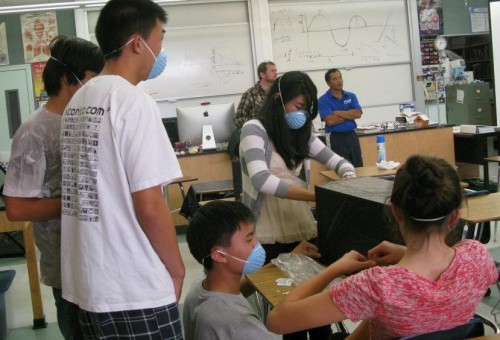 Proposal Summary:
Proposal Summary:
Throughout human history, bacteria and disease have been prevalent in every civilization. Modern medicine took its largest leap with the discovery of the first safe antibiotic: penicillin. As the world’s nations begin eyeing the depths of the final frontier, they must ensure the safety of the pioneers sent into space. Aboard the Apollo 13 mission, Fred Haise was infected by bacteria known as Pseudomonas aeruginosa, which survived in the water tanks aboard the space shuttle. P. aeruginosa is capable of living in nutrient deprived places, like dirt and distilled water, and is deadly to those with compromised immune systems. Its deadliness is not scientists’ only concern; P. aeruginosa is resistant to many common antibacterial agents, penicillin being one of them. Now that space travel is becoming more common, we must take more precaution to ensure the safety of our astronauts from the smallest of killers. By growing two samples of P. aeruginosa, one in space and one under the influence of gravity, and submitting both to various antibiotics, we are able to measure the antibacterial resistance of both cultures. The zones of inhibition, where the bacteria are unable to grow due to the antibacterial agent, accurately show how resistant P. aeruginosa is to each antibiotic. Any variation in the zones of inhibition of the same antibiotic between cultures would be due to any changes that occurred in the bacteria’s resistance when grown in space.
HONORABLE MENTION FINALISTS:
The Effects of Microgravity on the Growth and Catabolic Actions of the Oyster Mushroom, Pleurotus ostreatus
Grade 9; San Marino High School
Principal Investigator: Mark Liang
Co-Investigators: Mitchell Hee, Elizabeth O’Neal, Lauren Thai, and Sara Wong (one name witheld pending approval)
Teacher Facilitator: Wyeth Collo, Science Teacher
Proposal Summary:
This proposal focuses on the growth and uses of fungi in microgravity, specifically the Oyster Mushroom, Pleurotus ostreatus. Mushroom mycelium use catabolic actions to break down organic materials, giving it remedial potential on Earth and in space. Mushrooms have been proven to destroy oil, pests, and toxins. The organism is cost-efficient, sturdy, and versatile in its uses. To test these uses in space, the fungus will be grown in microgravity, under sterile lab conditions; the only variables present will be the organism itself and nutrients. A similar set will be grown on Earth. When brought back together, both samples will be initiated through a full life cycle. Afterwards, careful examinations will take place to define any changes in the mycelium’s structure (this involves an electron microscope), using the second strain as a ground truth. Because the experiment heavily emphasizes the uses of the mushroom, a set of experiments will directly gauge the breakdown process of the mycelia. Also to be emphasized is the stability of genetic information, to ensure generations of the fungi can continue. Our group hypothesizes that microgravity will have a direct affect on the organism, either in structure or function. Finding any correlations in the data defines an evaluation: the possibility of higher fungi uses in space. Other possible insight can delve into the science of decomposition itself.
Fibroblast Division in Microgravity
Grade 10; San Marino High School
Co-Principal Investigators: Jennifer Jiang, Jasmine Kuo, and Kara Lukas
Co-Investigator: (one name witheld pending approval)
Collaborator: Elyssia Widjaja
Teacher Facilitator: Wyeth Collo, Science Teacher
Proposal Summary:
Cell division is an integral component of life; all organisms must go through the cell cycle in order to grow, develop, and reproduce. Past experiments that have been conducted on Earth in simulated microgravity have shown that the lack of gravity causes cells to divide at a slower rate. We have decided to conduct further research concerning this topic and perform an experiment which will hopefully yield favorable results for science and humankind. The purpose of our experiment is to observe the effect of microgravity on cell division and to compare the rates of cell division in the absence and presence of gravity, which is dependent on the number of cells produced. The cells that we have chosen to experiment with are fibroblasts, which play a critical role in the healing of wounds. To test our experiment, the fibroblasts will be exposed to microgravity as they grow and proliferate; simultaneously, an identical experiment will be held to serve as a control. After the experiment has run its course, it will be brought back to us for analysis where we will compare the results with those of the control experiment. With the data from our experiment, we hope to improve the conditions of future life in space as well as to further our current scientific knowledge.
2. West Hills, California
Jump to West Hill’s Community Profile
SELECTED FOR FLIGHT:
Microgravity Wine
Grades 9 and 10; Chaminade College Preparatory
Co-Principal Investigators: Max Holden and Paige D’ Andrea
Teacher Facilitator: Nancy McIntyre, Program Director
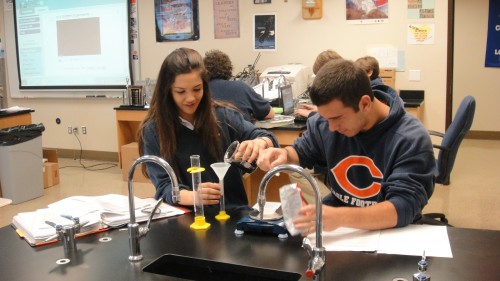 Proposal Summary:
Proposal Summary:
Our experiment will be testing the speed of fermentation when it is exposed to microgravity. When something is in microgravity it is in a constant free fall, so it will constantly be moving the solution of grape juice and yeast. When the sugar in the grape juice is mixed with the yeast it will begin to ferment due to lack of oxygen when it ferments it will produce ethyl alcohol and Carbon Dioxide. The microgravity will constantly be moving the cells in the solution, which we think will either speed up of slow down the process of fermentation. We will be testing the fermentation by using a titration rating, which will measure the amount of dissolved Carbon dioxide in the solution. By finding the titration rating we will be able to see if the one in an environment with gravity or the one in an environment without gravity produced more Carbon Dioxide. Whichever solution gave off more Carbon Dioxide is the one that fermented faster than the other.
HONORABLE MENTION FINALISTS:
Mold Rate in Space!
Grades 9, 10 and 11; Chaminade College Preparatory
Co-Principal Investigators: Alex Zuk, Amanda Grimes, Chandler Ramirez, Jasmine Rafferty, Melanie Frankera, and Samantha AdamsTeacher Facilitator: Nancy McIntyre, Program Director
Teacher Facilitator: Nancy McIntyre, Program Director
Proposal Summary:
The purpose of this experiment is to explore how microgravity affects the rate of mold. Our hypothesis is that the rate of mold growth will be greater in space than on earth because of the weightlessness. We will be putting processed romaine lettuce and homemade white bread, without any preservatives, into the nanotubes. Both nanotubes will be refrigerated. Once the nanotube arrives safely in space, we will be checking the growth of bacteria. We have decided to measure the growth every other day at 3 o’clock pm for a period of four weeks or less. During the duration of the month in space and on earth, we will take notes on the appearance of the bread and the lettuce. We are interested in this amazing opportunity to work with the SSEP to determine if bacteria grow, whether it is in space without oxygen or on earth with oxygen present. Without refrigeration, we are wondering if the growth of bacteria can be accelerated without presevatives or oxygen present. In addtion, we want to determine if water in romaine lettuce and the lack of oxygen affects the growth of bacteria. Romaine lettuce and homemade white bread, two ordinary products, will be put into two different environments – one with oxygen and one without. Determining how bacteria grow in each environment may acutally help us to determine the possiblity of life in outer space.
The Rusting of Iron and Steel in Outer Space
Grades 10 and 11; Chaminade College Preparatory
Co-Principal Investigators: Amir Zolfaghari, Austin Flores, Breanna Avery, Chloe Martin, Frank Tabino, Katrina Tirado, and Wyatt Oden
Teacher Facilitator: Nancy McIntyre, Program Director
Proposal Summary:
We are experimenting on the rusting of iron in space. We know that it is possible for metal to rust in space because there are still enough oxygen atoms to have a reaction on metals. We want to know what the difference in quality of rust on Earth and in space. We are also experimenting on the rusting of iron in space. For this experiment we will do the same as the steel, but with an iron wire instead. There will be no time limit for each for it could take a week or months. After the limit is reached, the results will be examined and a conclusion can be made if steel and iron does rust in space and how so and what is the process like.
3. Hartford, Connecticut
Jump to Hartford’s Community Profile
SELECTED FOR FLIGHT:
How Does Parathyroid Hormone Affect Changes in Bone Mass in Microgravity?
Grades 8 and 12; Annie Fisher Stem Magnet and University High School of Science and Engineering
Co-Principal Investigators: Nick Rapp, Bo-Edward Lawrence, and Samantha Cedeńo
Co-Investigators: Tristan DesRoires, Liam Flannery, and Roshawn Brown
Teacher Facilitators: Dr. Michael Fromerth, Science Teacher, and Keith Sevigny, Biology Teacher
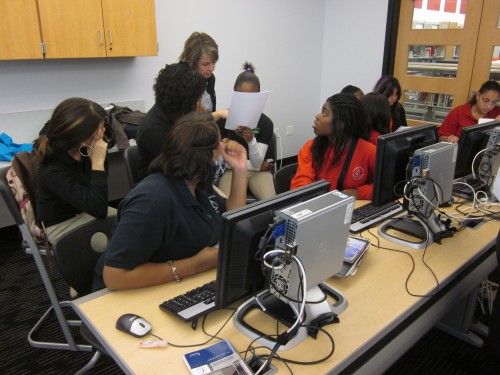 Proposal Summary:
Proposal Summary:
In our experiment we will be testing how microgravity would affect medicine used to treat bone loss (osteoporosis). Since we know that fluids behave differently in microgravity, we hope that by exposing these medicines to an environment with very weak gravity, the medicine might better promote the growth of bones. We are extremely interested in this project because we are aware of the problems osteoporosis has on the astronauts as they travel back in forth into space. We hope to help the studies of osteoporosis, and have an impact on the development of medicines today. When the experiment returns, we will examine the effect of the medicine in microgravity on the growth of bone cells.
HONORABLE MENTION FINALISTS:
Does microgravity change the rate in which cells heal?
Grades 8, 11, and 12; Annie Fisher STEM Magnet School and University High School of Science and Engineering
Co-Principal Investigators: Elijah Graham, Shamar Martin, and Naseeb Mirza
Co-Investigators: Milan Bond, Austin Colbert, and Eni Mete
Teacher Facilitators: Keith Sevigny, Science Teacher, and Dr. Michael Fromerth, Science Teacher
Proposal Summary:
This study examines the effects of microgravity on the rate of which cells heal, specifically the cell membrane. The chemical that damages the cell membrane we require are exotoxins. The two different types of exotoxins that damage the cell membrane are Perfringolysin O (PFO) and Intermedilysin (ILY). The damage applied to the cell membrane must be sub-lethal, so no cell organs are damaged. We will have a control experiment here to see whether microgravity does effect the time in which cells heal, be it slower or faster. We want to specifically test on animal cells. Our experiment is relevant because we want to see if cells can be restored under certain conditions such as microgravity, if an accident were to occur in space. No, this experiment wouldn’t have a huge effect on an organism, but if there is a healing factor, then this could be further explored.
How Fast Can Antibiotics Kill Bacteria in Microgravity?
Grades 8 and 12; Annie Fisher STEM Magnet School and University High School of Science and Engineering
Co-Principal Investigators: Willie Gant, Chris Johnson, and Jaquan Kerr
Co-Investigators: Khalim Dyer, Ashley Singh, and Khalil Hamilton
Teacher Facilitators: Keith Sevigny, Science Teacher, and Dr. Michael Fromerth, Science Teacher
Proposal Summary:
The proposal question that we have is how fast can tetracycline kill E. coli in microgravity. We hope that if our experiment is chosen we will find out if tetracycline will work faster or slower in microgravity. E. coli is a nonpathogenic bacteria and will be use to test the effectiveness of antibiotics in microgravity. Scientists are dismayed to discover that some bacteria have become resistant to antibiotics through various alterations, or mutations, in their DNA. Hospitals have become a breeding ground for antibiotic resistant bacteria. This experiment is important because many people are being hospitalized cause of their mutations in they DNA. Choosing this experiment would mean that we are helping thousands of astronauts who travel to use antibiotics that work well in space.
4. Washington, DC – Capitol Hill Cluster of Schools
Jump to Washington, DC’s Community Profile
SELECTED FOR FLIGHT:
Does Hay Bacillus Break Down Human Waste (Represented by Brown Egg) in Microgravity as Well as in Earth Gravity?
Grade 8; Stuart-Hobson Middle School
Co-Principal Investigators: Kyra Smith, Daiana James, and JaKayla Smallwood
Teacher Facilitators: Anthonette Peña, Richard Munz, Science Teachers
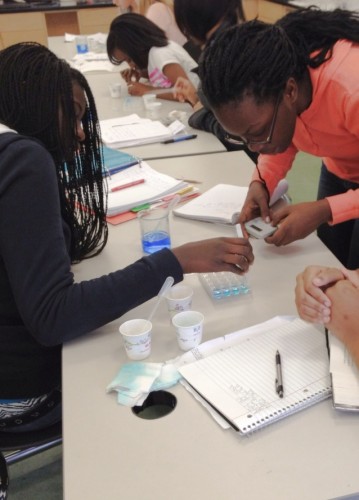 Proposal Summary:
Proposal Summary:
We propose the testing of Hay Bacillus’ ability to break down human waste (here represented by brown egg samples) in microgravity versus its ability in a septic tank on Earth. This experiment is relevant because if people on long space expeditions can recycle used water this significantly decreases the initial amount that they need to bring with them into space. This would also decrease the amount of space initially used to store the water, however a water recycling machine would probably take up the saved space if not use more. The experiment could also be a base for the testing of Hay Bacillus as an antibiotic, as it was used for cures to colon diseases like dysentery and as an immune system stimulant.
HONORABLE MENTION FINALISTS:
Hatching Fish Eggs in Micro-Gravity
Grade 8; Stuart-Hobson Middle School
Co-Principal Investigators: Marianne Warwick and Nora Pehrson
Teacher Facilitator: Anthonette Peña, Science Teacher
Proposal Summary:
For our project we will be sending Rainbow Trout fish eggs into micro-gravity. We are testing the differences between the hatching of fish eggs on earth and in space. All eggs must be of the same age, type and condition, and it is important that temperatures stay controlled and somewhat similar between the two environments (around 75-82 degrees Fahrenheit). We want to test this to see if aquatic life is sustainable in micro-gravity. This could possibly be a helpful discovery to scientists working to preserve certain endangered aquatic species, such as the Chinook salmon and the Yaqui catfish. We are hoping that if fish eggs can hatch in these conditions, it is possible that the eggs of endangered aquatic life can be brought into space to be grown and then the adult fish can be released into their natural environment where they will be less vulnerable then they would be if they were still in egg form.
What Does Microgravity Have to Do with Toothpaste?
Grade 8; Stuart-Hobson Middle School
Principal Investigator: Camille Gaskins
Co-Investigator: Jamila Spears
Teacher Facilitator: Anthonette Peña, Science Teacher
Proposal Summary:
My project is mainly trying to see if microgravity has an effect on teeth. We will also try to figure out if microgravity has a positive or negative effect on toothpaste. We will be testing in space as well as on the ground at the same time to determine if microgravity does have effect on the egg shells and toothpaste.
5. Lake County, Indiana
Jump to Lake County’s Community Profile
SELECTED FOR FLIGHT:
Effect of Microgravity on Reproduction of Curli Producing E. coli O157:H7 438950R
Grade 7; Avicenna Academy
Principal Investigator: Amalia Arceo-Hosken
Collaborators: Ameer Rifai, Jenna Rifai, and Rehan Uribe
Teacher Facilitator: Nicole Gustafson, Teacher
Proposal Summary:
In 1885, Theodor Escherich, a German pediatrician, first discovered Bacterium coli communeand in the solid wastes of healthy people. Eventually the species name was changed to reflect the man who discovered the bacteria, hence Escherichia coli. This experiment will be testing the effect of microgravity on reproduction of curli producing E. coli O157:H7 438950R. E. coli O157:H7 438950R is one of the E. coli strains that produce Curli. Curli are little things that stick out on the outside that help them stick together and help them when they attack other cells. This experiment will determine if microgravity has an effect on the production and/or expression of E. coli O157:H7 438950R‘s curli. With the future of space exploration focused on colonization of other planets, it’s important to know how disease-causing bacteria will act in different gravity.
SECOND EXPERIMENT SELECTED FOR FLIGHT:
The Effect of Microgravity on the Quality and Nutritional Value of the Seed Sprout of a Germinated 92M72 Genetically-Modified Soy Bean
Grades 7 and 8; Highland Christian School
Co-Principal Investigators: Jack Barth and JP Peerbolte
Collaborator: Cameron Zandstra
Teacher Facilitator: Sara Timmer, B.A. Teacher
Proposal Summary:
This experiment will be testing the effect of microgravity on the nutritional value of a 92M72 genetically-modified soy bean sprout. A large struggle for the International Space Station is the cost of shipping food from the Earth. If the astronauts were able to grow their own food on the space station, this cost would be almost eliminated. We believe that the sprout from a soybean would be an excellent nutritional food source for space travel. We will attempt to show that a soybean sprout grown in microgravity retains its nutritional value as compared to one grown on earth.
HONORABLE MENTION FINALIST:
Effects of Microgravity on Preserved Whole Blood Coagulation
Grade 7; Highland Christian School
Principal Investigator: Matthew Vargo
Co-Investigator: Ethan O’Riley
Teacher Facilitator: Sara Timmer, B.A. Teacher
Proposal Summary:
Today, outer space is an exciting part of our lives. It provides us with a unique laboratory, allowing scientific studies never before possible. The National Space Biomedical Research Institute has found that there are a number of important medical environmental differences between Space and Earth. Studying how the body depends on the laws of nature, this experiment will test the effect of microgravity on a 5cc sample of adult whole blood using the preservative K3EDTA to prevent clotting “in vitro” (outside the body) maintained in a vacuum tube. We know that the coagulation of blood “in vivo” (in the body) is affected by microgravity in space. The process of coagulation in space is slowed by “in vivo” factors. Protein crystals grown in space are of higher quality than those grown on Earth. This is proposed as an explanation for changes seen in blood coagulation in microgravity. Dr. Daniel Carter of NASA’s Marshall Space Flight Center found that this protein, which controls blood coagulation in human plasma is very difficult to grow in Earth-based laboratories because of the forces of gravity. Its successful growth in space, however, made it possible to further define its molecular model and understand how it works in the human body, which is important for medicine. Knowledge of blood flow in microgravity is required to modify homeostatic techniques for control of bleeding in traumatic injuries or surgical procedures in space. The results of this study could have major impacts on the safety of humans in space flight.
6. Ida County, Iowa
Jump to Ida County’s Community Profile
SELECTED FOR FLIGHT:
Killifish in Space
Grades 9–12; OA-BCIG High School
Principal Investigator: Jessica Gunderson
Co-Investigators: Christian Conover, Josh Dutler, Dane Hannel, Dylan Malcom, Levi Nunemaker, Lane Prather, Brittanie Rigby, Austin Sadler, Justin Sadler, and Amy Stangl
Teacher Facilitator: Carol Sadler, Life Science Instructor
Proposal Summary:
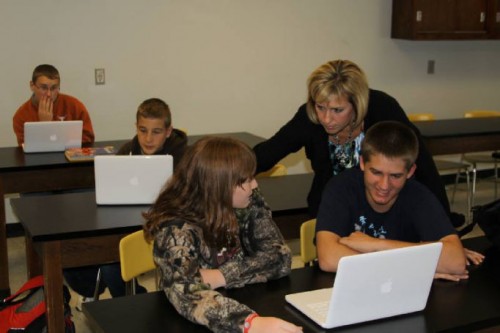 As a submitting project, we would like to send up dormant Killifish eggs. After settling on the ISS, these eggs will be rehydrated. After this process is completed, we will be able to begin the testing. When results are in, we will be able to tell if the bone and muscle mass of the fish had been affected, being micro-gravity’s pulling force is no where comparable to Earth’s gravity. Another part of this testing, since these fish have kidneys, would be able to tell if, even for such a small species, these animals have kidney stones. This testing will help with the health of humans.
As a submitting project, we would like to send up dormant Killifish eggs. After settling on the ISS, these eggs will be rehydrated. After this process is completed, we will be able to begin the testing. When results are in, we will be able to tell if the bone and muscle mass of the fish had been affected, being micro-gravity’s pulling force is no where comparable to Earth’s gravity. Another part of this testing, since these fish have kidneys, would be able to tell if, even for such a small species, these animals have kidney stones. This testing will help with the health of humans.
HONORABLE MENTION FINALISTS:
Glowing Bacteria in Space
Grades 9–12; OA-BCIG High School
Co-Principal Investigators: Austin Sadler and Justin Sadler
Co-Investigators: Brittanie Rigby, Amy Stangl, Christian Thomas, Jessica Gunderson, Josh Dutler, Dane Hannel, Lane Prather, Levi Nunemaker, and Dylan Malcom
Teacher Facilitator: Carol Sadler, HS Science Teacher
Proposal Summary:
pGLo is a gene extracted from jellyfish that glows in the presence of arabinose sugar and is resistant to ampicillin. On Earth the gene once inserted into bacterial DNA causes bacteria such as E.coli to glow in the presence of arabinose and grow in the presence of ampicillin. This lab goes to show that on Earth, if pGLO is a wild occurring plasmid, that we would have to change our ways of medicine because antibiotics as we know them will not be affective anymore. In space when we make the trip to Mars we need to know if that if pGLO or another medicine resistant gene gets there, we may have change how we treat diseases. The main point for this lab is to know more about medicines for a trip and possible colonization of Mars and other planets and their surrounding moons.
The Process of Crystallization of the Protein Lysozyme in Space
Grades 9–11; OA-BCIG High School
Principal Investigator: Brittanie Rigby
Co-Investigators: Levi Nunemaker, Josh Dutler, Jessica Gunderson, Lane Prather, Austin Sadler, Justin Sadler, Amy Stangel, Christian Thomas, Dylan Malcom, and Dane Hannel
Teacher Facilitator: Carol Sadler, Life Science Instructor
Proposal Summary:
For this experiment we would like to find out if the process of crystallization, of the protein lysozyme, would be effected in an environment without gravity. We know that there have been perfect crystals formed in space before, and we are wondering if that can happen with proteins also. We wonder this because we know water acts differently in space as well as many other liquids, because the density and weight does not matter when you are in space. We would like to know if this experiment would be able form perfect crystals, larger, smaller crystals, or maybe even no crystals at all compared to the experiment conducted in an environment with gravity.
7. Charles County, Maryland
Jump to Charles County’s Community Profile
SELECTED FOR FLIGHT:
The Physiological Effects of Microgravity and Increased Levels of Radiation on Wild-Type and Genetically Engineered Caenorhabditis elegans
Grade 11; Henry E. Lackey High School
Principal Investigator: Paul Warren
Teacher Facilitators: Lara North and Romulo Gabriel, Science Teachers
Proposal Summary:
The experiment detailed herein investigates the physiological effects of microgravity and increased levels of radiation on various systems of two sets, each with a copy of two strains of Caenorhabditis elegans, one set grown in space under the influence of microgravity and increased radiation levels, and the other set grown on Earth under the influence of normal levels of gravity and radiation levels. The first strain will be the wild-type C. elegans strain. The second strain will have a mutated daf-2 gene which has been observed to double the lifespan of C. elegans and increase the lifespan of other species, including humans. It is hypothesized that microgravity and increased levels of radiation will significantly alter the physiological properties of the biological systems of the C. elegans strains and negatively affect the daf-2 mutation, thereby decreasing the lifespan of the genetically modified C. elegans strain, although the genetically modified strain will still have a longer lifespan than the wild-type strain. Halves of the two sets of strains of C. elegans will be compared under a Stereo Light Microscope with a Digital Camera attached and a Scanning Electron Microscope at the University of Richmond for physiological differences. The other halves will be examined daily under a x25 microscope for evidence of altered reproductive cycles, and lifespans. Because C. elegans have been extensively experimented with, and the developmental patterns of all 959 of its somatic cells have been traced, such differences should be easily found. This information can then be used to make inferences about how future space travelers can prepare themselves from the potential side-effects of microgravity and increased levels of radiation.
HONORABLE MENTION FINALISTS:
The Effect of Microgravity on How Quickly Fruit Rots
Grade 5; Dr. Thomas Higdon Elementary School
Co-Principal Investigators: McKenna Simpson, Katie Czysz, Jack Koch, Carly Rodgers, Ryan Summy, and Caleb Griffith
Teacher Facilitator: Karen Dempsey, Gifted Teacher
Proposal Summary:
We have designed an experiment to test the effects of microgravity on the rate at which fruit will rot. This information would be useful so that astronauts will not have to eat rotten food. Also, they will know how much time they have until they will need to get more food. This will also help if we are ever able to colonize other parts of space, such as the moon, but have trouble getting plants to grow for fresh food. This experiment will give an idea of how fruit will rot in space and could lead to other investigations into how other fresh foods respond to microgravity.
The Effects of Micro-Gravity on the Properties of Cement
Grade 9; La Plata High School
Co-Principal Investigators: Klahr Clark and Bethany Riege
Teacher Facilitator: Todd Sharp, Earth Science Teacher
Proposal Summary:
The hypothesis to be tested is: If cement is formed under the conditions of micro-gravity, then its properties will be enhanced compared to that of the cement formed on Earth. Since the denser materials wouldn’t sink, then the solution could possibly end up stronger. It could be used in a variety of construction projects to strengthen structures against numerous natural disasters. It could strengthen buildings from earthquakes, causing less damage to cities, and possible stop much of the fatalities that occur from falling debris. This experiment could end up leading to other experiments based off the data collected, further progressing humans and science.
8. Fitchburg, Massachusetts
Jump to Fitchburg’s Community Profile
SELECTED FOR FLIGHT:
Effect of Arthrobacter on Polyethylene Decomposition Rate in Microgravity
Grades 10 and 12; Montachusett Regional Vocational Technical School
Co-Principal Investigators: Russell Holbert, Victoria Holbert, Brittany Velez, and Miguel Velez III
Teacher Facilitator: Paula deDiego, Science Instructor
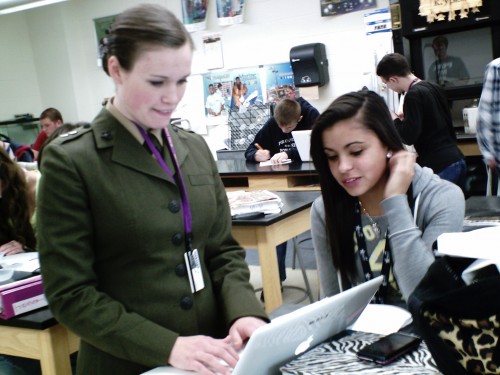 Proposal Summary:
Proposal Summary:
The purpose of this experiment is to determine if a culture of the genus Arthrobacter has a noticeable increase in the decomposition of polyethylene. Arthrobacter is a genus composed of bioremediators: microorganisms that remove pollutants from the environment. These bacteria are capable of hydrolyzing polyethylene, a hydrocarbon polymer. In bringing these plastics into microgravity, we hope to discover a more efficient way of degrading plastics, and possibly isolating the sole species responsible for it.
HONORABLE MENTION FINALISTS:
Affect of Microgravity on Helicobacter pylori
Grade 10; Montachusett Regional Vocational Technical School
Co-Principal Investigators: Gage Butler, Jessica Shattuck, and Jacklyn White
Teacher Facilitator: Paula deDiego, Chemistry Instructor
Proposal Summary:
Our proposal is to find out the affect of microgravity on Helicobacter pylori. This bacteria is extremely hard to cure. We will find out the affect by conducting a ground experiment to compare the results. These tests will include an ammonia test, liquid carbon-dioxide test, pH level test, and an optical density test. This will help us determine the change in bacteria population, and amount of enzymes sent out. We will send up freeze dried H. pylori and activate it by releasing Brucella broth, which will provide food and energy for it to grow and reproduce. The H. pylori will be activated 35 days into the flight, giving it 7 days to grow and reproduce before being sent back to Earth.
Effects of microgravity on Synthetic Blood
Grade 11; Montachusett Regional Vocational Technical School
Co-Principal Investigators: Yeniffer Araujo, Nadia Machado, Tiffany Nguyen, and Ryan Swift
Teacher Facilitator: Paula deDiego, Chemistry Instructor
Proposal Summary:
Our project proposal revolves around one central concept: What effect does microgravity have on synthetic blood? To test this, we plan to place two samples of synthetically made blood components in a preservative under controlled conditions. As one of these samples leaves the Earth’s gravitational hold, it will undergo a change in ambient pressure due to the lack of downward force. The purpose of this experiment is to determine if this change in pressure will cause anything within the samples to change or stop working all together.
9. Pleasanton and Norris, Nebraska
Jump to Pleasanton’s and Norris’s Community Profile
SELECTED FOR FLIGHT:
Escherichia coli in Microgravity
Grade 12; Norris High School
Co-Principal Investigators: Amanda Gosselin, Janessa Onwiler, Brianna Petersen, Madison Schoenbeck, and Holly Schurman
Teacher Facilitator: Cindy Larson-Miller, High School Science Teacher
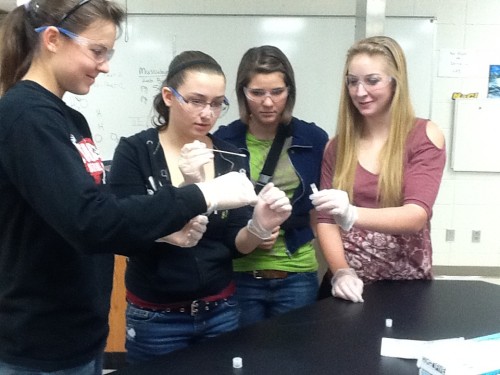 Proposal Summary:
Proposal Summary:
This experiment studies the effects of microgravity on the DNA of pathogenic bacteria. We will send both Escherichia coli (E. coli) bacterial cells, which will be rehydrated in flight, and extracted E. coli DNA into space to determine if bacterial DNA degrades in microgravity and the extent of any such degradation. Two experiments are included because there is a risk that the rehydrated E. coli may die before the DNA can be extracted and analyzed, which would cause DNA degradation not due to microgravity. Therefore, a vial filled with previously extracted E. coli DNA will also be included, which will survive the length of the space flight. When the experiment returns from the International Space Station (ISS), we will extract the DNA from the rehydrated E. coli, use restriction enzymes to create DNA fingerprints of the genome and analyze the results with horizontal gel electrophoresis. The second experiment, the E. coli DNA extracted prior to the space flight, and the control DNA will be cut using the same restriction enzymes and analyzed with gel electrophoresis for comparison. By analyzing the DNA fingerprints, we will determine if significant degradation has occurred, changing the DNA fingerprint of the bacteria.
HONORABLE MENTION FINALISTS:
Brine Shrimp Project
Grade 9; Norris High School
Co-Principal Investigators: Autumn Pella, Carlee Koehler, Eli Lundak, and Matthew Rohman
Teacher Facilitator: Rachel Goracke, Teacher
Proposal Summary:
We would like to test how microgravity affects the hatching of brine shrimp. If they hatch the same way in microgravity as in earth’s gravity, then we will be able to raise brine shrimp in microgravity as a source of food. We will do this by combining salt water as well as brine shrimp eggs, and observing how they hatch in microgravity. We will then compare the results of those hatched in microgravity, to ones hatched in earth’s gravity, the only variable being the gravity. That way we can see how gravity-or rather the lack of gravity in this case-affects the hatching of brine shrimp eggs.
Staphylococcus epidermidis
Grade 12; Pleasanton High School
Co-Principal Investigators: Brady Darby and Adam Ripp
Teacher Facilitator: Alison Buescher, Science Educator
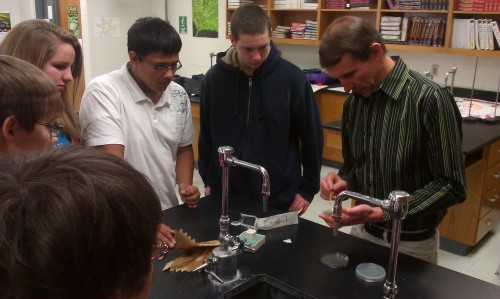 Proposal Summary:
Proposal Summary:
Staphylococcus epidermidis is a common cause for infection and disease in hospitals on Earth. But how will the bacteria react in space? Will microgravity inhibit or accelerate the growth rate? Will this data be applicable to finding more efficient methods of treating infections caused by Staphylococcus epidermidis? We hope to answer these questions by studying microgravity’s effect on the growth rate of Staphylococcus epidermidis. We will send freeze-dried Staphylococcus epidermidis, along with an activating agent and a growth medium in the test tube. The data from the experiment on the International Space Station will be analyzed and compared to data from growth rates in a controlled experiment on Earth. If there is an increased risk for astronauts to contract a disease caused by Staphylococcus epidermidis, we hope the potential amplified threat will be exposed in the information from these experiments. The results of the experiments will also help us to understand the growth of the bacteria, which would therefore assist in the development of medical treatment of the infections, both on Earth and in space. Knowledge of the bacteria could even lead to the development of a vaccine for Staphylococcus epidermidis and possible solutions to methicillin-resistant strains of Staphylococcus. This research could prove to be beneficial for everyone, from those who have already contracted the disease to those who at risk of contracting the disease, including astronauts on the ISS and medical practitioners in hospitals throughout the world.
10. Cincinnati, Ohio
Jump to Cincinnati’s Community Profile
SELECTED FOR FLIGHT:
Spider Development and Gravity
Grade 5; Quebec Heights
Co-Principal Investigators: Santoria Bacca-Canales, Damien Godby, and Madison Hicks
Co-Investigators: Chiana Balcaitis, Chastity Ortiz, and Devin Rowe
Collaborators: Savannah King and Alyson Reupert
Teacher Facilitator: Vicki Witkowski, 4/5 Science Teacher
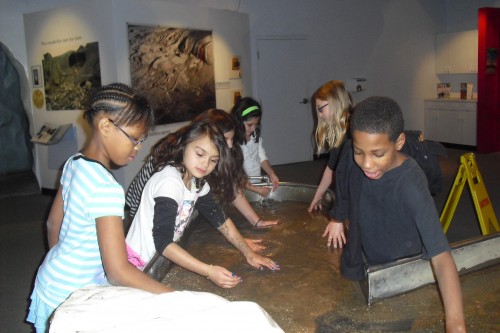 Proposal Summary:
Proposal Summary:
Experimenters will see how micro-gravity affects the developments of the orb spider. We have learned that NASA has already sent orb spiders into space to see the effect of gravity on the adult spider. We also have learned from this experiment that spiders can live without food for three weeks if water is available. We would like to continue this experiment by seeing what effect gravity has on the development of the eggs. We would also like to look for the differences and/or similarities of spiders hatched in space and on earth. We will observe and measure the size of the spider in millimeters, its color and the physical development of body parts (i.e. number of legs).
Due to the limitations of space, light and our controlling temperatures, there will be a control egg sac. This sac will be in an aquarium because we want to know how the spiders develop without us changing anything from the natural state. We will be comparing the FME in space to the FME on Earth. Then we will compare these findings to the spider development in the aquarium. If the development of the spiders in space is good, we hope that it will lead to more experiments using a variety of animals hatching from eggs. This can help in many ways such as producing food chains or possibly having fresh food such as chicken eggs in space.
SECOND EXPERIMENT SELECTED FOR FLIGHT:
Yeast in Space!
Grade 6; Cincinnati Gifted Academy
Co-Principal Investigators: Nathaniel Graichen and Shmu-el Ocho
Co-Investigators: Edwin Segbefia and Yusuf Said
Teacher Facilitator: David Haase, Teacher
Proposal Summary:
The experiment we propose is to study the growth of Balcer’s Yeast or S. cerevisiae in a microgravity (OG) environment. We would like to observe the physical characteristics of yeast in microgravity and compare it to yeast grown under normal gravity. We chose yeast because it is readily available, may be transported in a dormant state and activated easily. Also, yeast has a long and delicious history with human kind. If yeast acts in a similar or same way in microgravity it may be a useful organism for future missions as a food ingredient. We plan to use an FME-type 3 mini-lab; with this we can keep the yeast separate from a nutrient broth (10.5% sucrose in distilled water) until orbit, when they will be mixed. After the yeast has had time to grow for a six hours period of time, introducing a 70% ethanol solution will terminate the experiment. This way re-entry and transport after landing will not affect the yeast and both the in orbit and ground truth experiments may be compared.
HONORABLE MENTION FINALISTS:
Sea Monkeying Around in Orbit
Grade 6; Cincinnati Gifted Academy
Principal Investigator: Madalyn Hayden
Co-Investigators: Meghan Cholak, Sam Colston, Connor Pickering, and Morgan Sippel
Teacher Facilitator: David Haase, Teacher
Proposal Summary:
In order to observe the effects of microgravity on microorganisms, we will hatch brine shrimp in orbit on the International Space Station. The experiment will be prepared using an FME type-3. The main volume will contain a saline solution, ampoule A will contain air and ampoule B will contain the brine shrimp eggs and a dried food source. In orbit ampoule A will be cracked and mixed to oxygenate the saline solution, then ampoule B will be cracked open and the food and shrimp will mix with the solution. Introducing the brine shrimp to the saline solution will trigger hatching. We hope to learn if the microgravity environment has any affect on hatch rate, male female ratio, color and size, as well as, to see if there are any observable deformities associated with microgravity.
11. Houston, Texas – Johnston Middle School
Jump to Houston’s Community Profile
SELECTED FOR FLIGHT:
Hepatocyte Development in Bioscaffolds infused with TGFB3 in Microgravity
Grade 8; Johnston Middle School
Principal Investigator: Emily H. Soice
Teacher Facilitator: Nicole DiLuglio, IPe Teacher
Proposal Summary:
This project explores whether a bioscaffold infused with TGFB3 grows and forms structures of hepatocyte cells faster in microgravity than in normal gravity. This project builds on and combines previous work on: 1) the ability of hepatocytes to form structures in bioscaffolds in a simulated microgravity environment that could not be formed in normal gravity; 2) the accelerated growth of cartilage cells grown in bioscaffolds infused with growth factor beta 3 (TGFB3). Further understanding of improved bioscaffolding in microgravity with the addition of growth factor to increase rate of growth lays the ground work for the eventual growth of replacement tissue, joints, and even organs that is not currently possible in normal gravity. In this experiment, hepatocytes will culture in space for two days and then be preserved with formaldehyde so that it can be returned for analysis. Upon return to normal gravity, the cell growth and formation will be compared with the control group that has been developed in normal gravity, both with and without TGFB3 infusion into the growth medium.
SECOND EXPERIMENT SELECTED FOR FLIGHT:
Will Vitamin C Preserve Bone Density in Microgravity?
Grade 5; Parker Elementary School
Co-Principal Investigators: Maxx Denning, Michael Prince, and Aaron Stuart
Teacher Facilitator: Rebecca Mitchell, 5th Grade Teacher
Proposal Summary:
Our experiment will test to see if liquid Vitamin C will preserve bone density in microgravity in a chicken bone. Our team is conducting this experiment to prove whether or not vitamin C can preserve bone density. First, we will split a wish bone in half. Next, we will place one half in each FME. Finally, one wish bone half will be flown in a chamber into space. The other bone sample will be remain in the same type chamber on earth. When the one from space returns, we will measure the affects of microgravity on the bone and compare it to the sample on earth in an effort to see if liquid Vitamin C did preserve bone density.
If liquid Vitamin C helps preserve bone density, then this will be helpful to astronauts who stay in space over a long period of time. Astronauts can take vitamin C in addition to exercising to help keep their bones strong. This issue is more important than ever because we know that WHEN we go to Mars, it will take about 21 months (round trip). If we cannot find a way to preserve bone density, the astronauts will lose over one half of their bone density on a long term mission. On earth, this knowledge will help people by encouraging them to take Vitamin C to keep their bones strong.
HONORABLE MENTION FINALIST:
Insulin’s Molecular Structure in Microgravity
Grade 8; Johnston Middle School
Principal Investigator: Aunjanee Cooper
Collaborators: Clarence Ross, Deputy Division for Quality and Flight Division NASA; Lawrence Pinsky, Physics Department University of Houston; Ramanan Krishnamoorti (Dow Professor & Chair of Chemical & Biomolecular Engineering, University of Houston
Teacher Facilitators: Lanena Berry and Nicole Diluglio, AVID and IPC
Proposal Summary:
There are about 25.8 million people in the United States who have diabetes. There are two types of diabetes: Type 1 diabetes, which has no insulin being produced by the pancreas. Type 2 diabetes has very little insulin being formed. In this experiment the affect that microgravity has on insulin’s molecular structure will be tested. There is diabetic history in my family. By doing this experiment, I hypothesize that the insulin’s molecular structure will change and still be effective in microgravity and when it gets back to earth.
Since there is a significant amount of radiation on the ISS; the experiment that will be conducted on earth will be at a radiation lab at MD Anderson hospital working with Dr. Pinsky from University of Houston; so that it can be infused with the same amount of radiation that is on the ISS. After two weeks of being refrigerated on the ISS; the ampoule will be exposed to the ambient temperature aboard the international space station. The experiment will only be conducted for 30 days so the insulin will last. After the days are done the insulin will be mixed with a fixative (Bouin’s Fixative). When the experiment reaches the ground it will be taken to University of Houston’s lab where it will be analyzed; by being put under a scanning electron microscope I will be able to see if the molecular structure is different from the experiment that was conducted on the Earth.
12. El Paso, Texas
Jump to El Paso’s Community Profile
SELECTED FOR FLIGHT:
The Effect of Microgravity on the Use of Cactus Mucilage for Water Purification
College Sophomores; El Paso Community College Valle Verde Campus
Co-Principal Investigators: Naiqui Armendariz and Jesus Castor
Collaborators: Dr. Maria Arteaga, Professor of Chemistry, El Paso Community College, Transmountain Campus; Dr. Bencomo-Álvarez Alfonso Enrique, Laboratory technician of molecular-microbiology diagnostics, Centro de investigación biomédica de occidente, Guadalajara, Jalisco, México; Dr. Norma A. Alcantar, Associate Professor, Dept. of Chemical & Biomedical Engineering, University of South Florida
Teacher Facilitator: Dr. Gertrud Konings-Dudin, Assistant Professor of Biology, El Paso Community College, Transmountain Campus
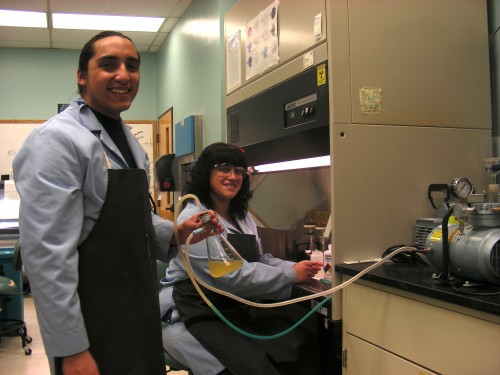 Proposal Summary:
Proposal Summary:
Cactuses are incredible organisms due to their diverse beneficial features such as: the growing of penicillin on the roots, excellent source of carbohydrates and minerals, great endurance to harsh conditions, great for human hydration, and the recently found feature of using cactus mucilage to purify water. For all these reasons, cactuses are a wonderful candidate for future space farms. In fact, cactuses are already being tested for spatial use. The main focus of this experiment is to test the ability of Opuntia ficus-indica’s mucilage to purify water. We will be testing the possible use of its mucilage to clean water contaminated with chromium, in space. This characteristic of the mucilage may have helpful benefits in the future mainly for two reasons: purification of moon water and possible recycling of the water used in space missions. This experiment will be focusing on the possible purification of the water found on the moon. Chromium can be found on the moon in small proportions, but it can be very harmful if ingested [4]; that is the reason we will be testing the removal of this mineral from water. If mucilage water-purification proves to be unaffected by microgravity, the process may be viable for the purification of the moon’s water.
HONORABLE MENTION FINALISTS:
The Effects of Microgravity on Seed Germination in Opuntia ficus-indica inoculated with Penicillium notatum
College Sophomores; El Paso Community College Transmountain Campus
Co-Principal Investigators: Marivel Contreras, Eduardo Garcia, Michelle Garcia, and Samantha Lucas
Proposal Summary:
The study of plants in microgravity is of great importance for long-term human space exploration. Opuntia ficus-indica (Indian fig prickly pear) is a superb candidate for spaceflight given that it is edible, has known medicinal properties and is able to thrive in harsh environments. The fungus Penicillium notatum has been shown in our laboratory to have a positive effect on the germination rates of Opuntia seeds by helping to break seed dormancy. The goal of our experiment is to assess if exposure to micro-gravitational conditions influences the effect of Penicillium notatum on Opuntia ficus-indica seeds. To perform this experiment, we will expose five cotton-wrapped O. ficus-indica seeds to a P. notatum-deionized water suspension for a period of four weeks while exposed to microgravity and normal gravity conditions at room temperature in the dark. Germination rate will be determined by a physical count of the sprouted seeds to obtain a percentage of germinated seeds.
